Physical Address
304 North Cardinal St.
Dorchester Center, MA 02124
![]() Access video lecture content for this chapter online at Elsevier eBooks+
Access video lecture content for this chapter online at Elsevier eBooks+
Traditional facelift techniques have relied upon the tightening of thin flaps of aging skin to elevate and support sagging, deeper facial tissues. Although initial results from these procedures often appeared good, early recurrence of the original problems were common, and poor scars and healing problems were frequently seen due to obligatory wide flap undermining and unavoidable skin flap tension. These procedures also typically produced an easily recognized and objectionable tight-appearing, “facelifted” look that was usually exacerbated by subsequent similar procedures.
As surgeons have pursued more natural-appearing and long-lasting outcomes, our understanding of the aging process has improved and facelift techniques have evolved. Experience has shown that an attractive and natural-appearing result is not possible without diverting tension away from the skin to the superficial musculo-aponeurotic system (SMAS) and platysma, and unless the aging midface is addressed.
The traditional “low” cheek and “deep plane” SMAS flaps elevated below the zygomatic arch suffer the drawback that they cannot, by design, exert and effect on tissues of the midface and infra-orbital region. “Low” and “deep plane” designs target the lower cheek and jowl only, and produce little if any improvement in the upper anterior cheek area. Planning the flap “higher”, at the level of and along the zygomatic arch, and extending the dissection medially in an “extended SMAS” fashion to mobilize midface tissue, overcomes this problem and allows a combined, simultaneous lift of the jawline, cheek, and midface. When performed as described an improved outcome is obtained and no separate midface lift procedure is needed.
The fundamental flaw in “skin-only” facelifts, “mini-lifts”, and similar non-SMAS procedures is the fact that skin was intended to perform a covering function and not a structural or supporting one. Skin is inherently elastic and was intended to stretch and move as we emote and express ourselves. It was not intended to support sagging muscle, fat, and other structures lying underneath it that descend with age. Attempts to lift sagging deep layer tissue by tightening and removing skin corrupts its covering function and results in abnormal skin tension and related secondary problems, including poor scars, tragal retraction, earlobe malposition, and a tight and unnatural appearance. Skin tension also flattens contour, rather than restoring it, and because skin stretches as tension is applied, objectionable temple, sideburn and occipital hairline displacement is common when “skin-only” techniques are used. In addition, because skin is inherently elastic and not capable of providing a sustained support of deep facial tissues, the results of most “skin-only” facelifts, “mini-lifts” and other non-SMAS procedures are usually short-lived.
Using the SMAS to restore facial contour overcomes many of the problems associated with skin-only lifts as it is an in elastic structural layer that is attached to and envelopes facial tissues sagging with age, and it is capable of providing meaningful and sustained support. Although skin must be excised in SMAS procedures, and proper excision will produce an improved result, only truly redundant tissue is removed and closure is properly made under normal skin tension. Facial skin so treated will distribute itself naturally over new contours created by SMAS modification and is capable of some self-repair and contraction. This averts a tight or “lifted” appearance, provides for optimal wound healing and well healed scars, and further enhances the overall end result.
The midface is generally defined as an inverted triangular area situated over the anterior upper cheek that is bounded by the zygomaticus major muscle laterally, the nasolabial fold medially and the orbitomalar ligament superiorly. In healthy, youthful-appearing individuals this area is full and makes a smooth transition into the adjacent cheek and lower eyelid. As a person enters their early mid-life and beyond, there is generally atrophy and a loss of volume from this area. Over time this results in a loss of confluence with the fat of the lower eyelid and cheek and, eventually, an elderly, or even ill and haggard appearance. Midface atrophy is felt by some surgeons to also be accompanied by descent of midface tissues, and the aging change seen in the upper cheek area is, as a result, often (although perhaps imprecisely) thought of and referred to as midface “ptosis”.
The recognition of midface “ptosis” as a component of the changes occurring in the aging face, combined with the realization that the traditional SMAS facelift produced little or no improvement in the midface region, has led to a variety of procedures designed to specifically target the midface area. Many of these “midface lifts” have been designed to be performed as isolated procedures or have been performed in conjunction with lower eyelid surgery.
Although there is merit in the idea of rejuvenating the midface, routine isolated midface lift procedures have been largely abandoned, and a consensus of opinion as to how and when they should best be performed has never been reached. Most midface lift procedures have a steep learning curve and have been fraught with complications, especially those performed through a blepharoplasty incision. These complications include lid retraction, ectropion, canthal displacement, and related corneal exposure and dry eye problems. As a result, many midface lift techniques have necessarily come to incorporate potentially problematic aggressive adjunctive surgical maneuvers including canthotomies, canthoplasties and orbicularis oculi muscle suspensions to reduce the likelihood of these problems occurring. These maneuvers often result in a “changed look” that is disturbing to many patients, however, and carry a high risk of significant and troublesome complications of their own.
Careful evaluation of patients who need or request a midface lift will show that most also need a facelift. It is rare to encounter a patient with midface aging who does not also have sagging in the cheek and jowl, and midface lifts are, as a result, arguably more logically performed in conjunction with a formal facelift procedure. When performed together improvement is more balanced and comprehensive, and a more harmonious and natural-appearing result is usually obtained.
Experience has also shown that healing is faster and complications are less likely if midface improvement can be obtained through the facelift incision, rather than through a blepharoplasty or intra-oral approach.
Analysis of the aging face will also show that midface lifts are generally conceptually flawed in that they erroneously assume the problem seen in the anterior upper cheek to be solely one of tissue ptosis. Failure to acknowledge the fact that atrophy is present to a significant degree in most cases has led to general long-term disappointment for both patients and surgeons following many procedures, and has resulted in the addition of dermis fat grafts, orbital fat transposition, “septal resets” and similar maneuvers to midface “lift” techniques. It has proven questionable whether midface procedures can provide a restoration of lost volume as simply, naturally, and effectively as can be obtained with autologous “micro” fat grafting.
The traditional “low” cheek SMAS flap elevated below the zygomatic arch suffers the drawback that it cannot, by design, have an effect on tissues of the midface and infra-orbital region. Low designs target the lower cheek and jowl only and produce little if any improvement in the upper anterior cheek area. Planning the flap “higher”, along the border of the zygomatic arch, and extending the dissection medially in an extended SMAS fashion (see Fig. 9.8.2B ) to mobilize midface tissue, overcomes this problem and produces an improved result ( Fig. 9.8.1 ).
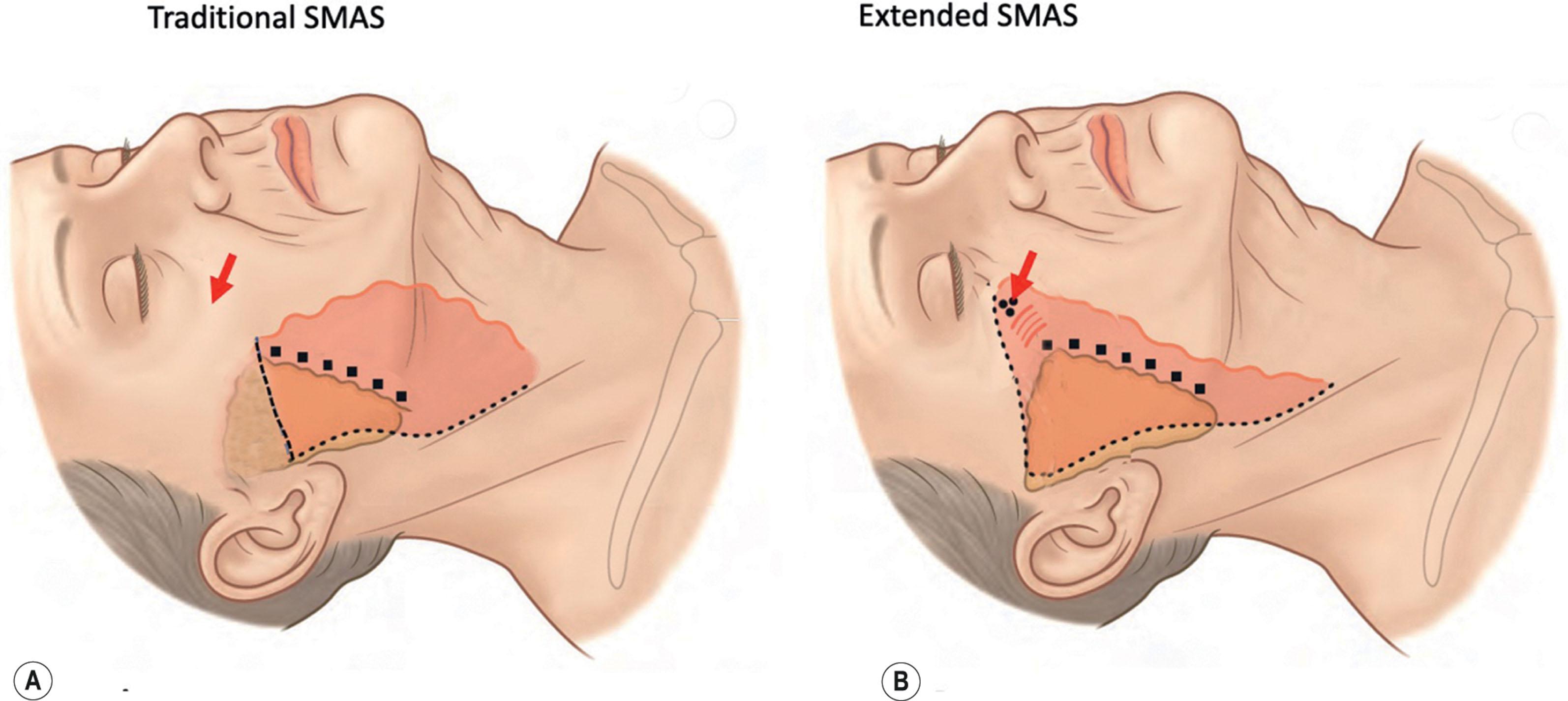
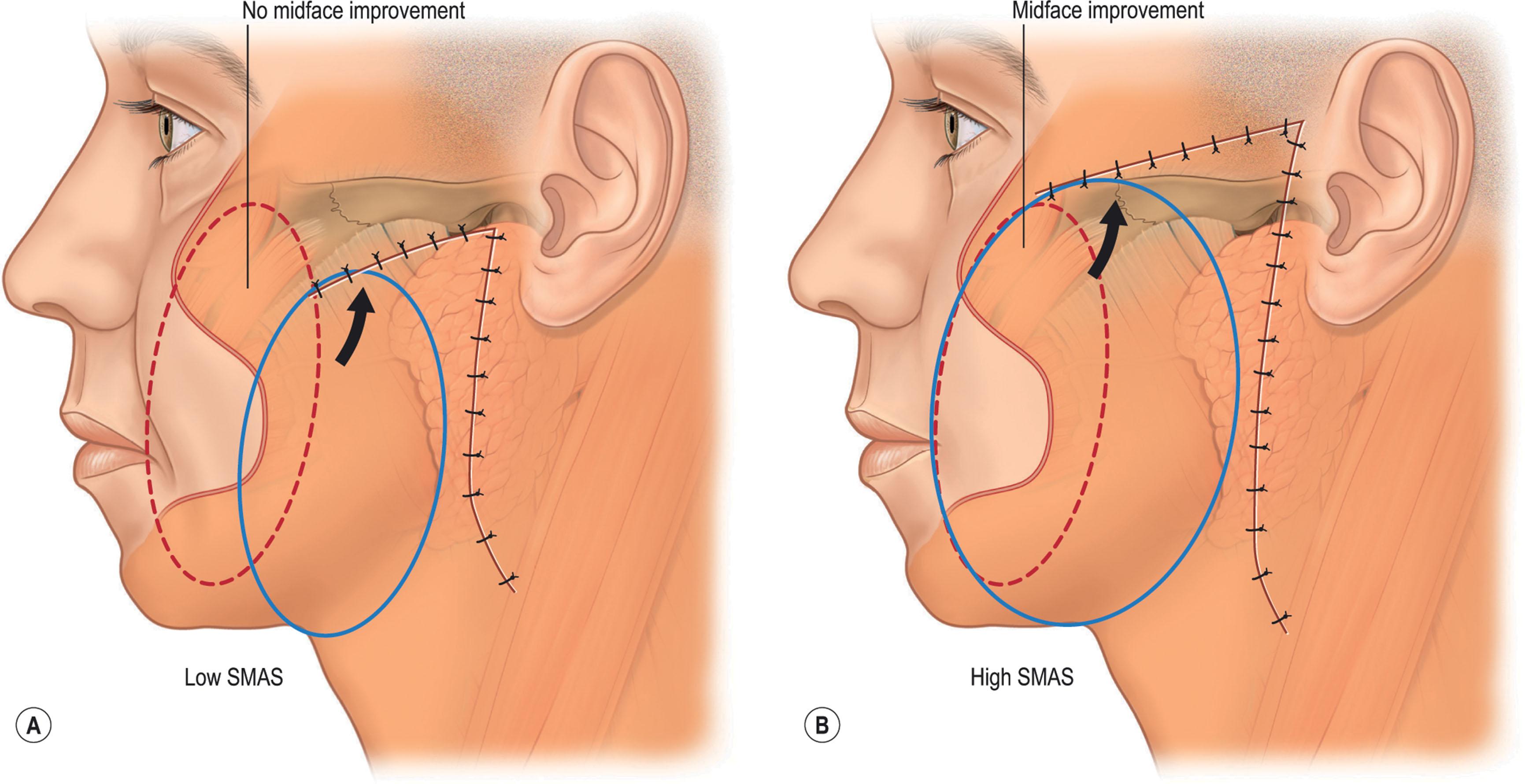
Benefits of the high SMAS technique include a combined, balanced, and harmonious elevation of sagging tissues of the midface, cheek and jawline, without the need to perform a separate or distinct midface lift procedure. High SMAS procedures are also readily combined with midface fat grafting since midface and infra-orbital tissue planes are not opened or dissected. This averts the need to perform complex and potentially problematic procedures in which orbital fat is transposed, the orbital septum “reset”, or free grafts are placed.
At least part of the popularity of “low” SMAS designs can be attributed to concerns regarding anatomical constraints about the zygomatic arch and laudable efforts to design flaps that could be dissected safely without jeopardizing the frontal branch of the facial nerve. Published studies and a careful appraisal of frontal branch anatomy, however, show that a “high” dissection is anatomically sound and, clinically safe. For most patients, the repositioning of midface tissue obtained with a “high” SMAS flap will be satisfactory, and no additional or separate midface lift procedure will be required.
The extended SMAS concept is integral to the high SMAS technique and the means by which midface tissues are liberated and subsequently elevated in an integrated fashion when a high SMAS flap is raised ( Fig. 9.8.2 ).
The extended SMAS concept as set forth by Stuzin is not synonymous and should not be confused with the “extended SMAS technique” , the latter being the name Stuzin gave to his personal facelift technique in which a high SMAS flap is dissected but the posterior part of the superior flap margin is set below the zygomatic arch and a more medially situated tab of SMAS tissue is created over the lateral zygoma as part of the SMAS flap that can be used to lift midface tissues.
Stuzin’s extended SMAS concept was a groundbreaking one that clarified certain anatomical realities that had gone unrecognized by other surgeons employing SMAS techniques, and it comprised a new and important approach in treatment of the midface during facelift procedures that remains important and germane to this day.
Traditional SMAS dissections targeted largely the lower cheek SMAS and platysma and focused on releasing more inferiorly situated masseteric-cutaneous ligaments restraining the lower cheek and posterior jawline areas (see Fig. 9.8.2A ). These types of dissections were likely undertaken in large part because they were relatively easier to perform in comparison to dissecting more superiorly, and perhaps due to the hyperfocus on the jawline and lack of awareness of the need to also reposition the midface that was prevalent at that time.
In the extended SMAS approach, dissection is limited in the lower cheek to the release of the masseteric-cutaneous ligaments that are situated along the anterior border of the parotid, in recognition of the fact that a more extensive dissection serves no purpose and does not provide an improved release. Instead, focus is directed more superiorly to release the zygomatic ligaments situated near the origin of the zygomaticus major muscle origin and their confluence with upper masseteric-cutaneous ligaments situated just inferior to that, which was not done in traditional “non-extended” SMAS dissections (see Fig. 9.8.2B ). Extending the SMAS flap dissection up over the zygoma and into this area and releasing these more superiorly situated ligaments restraining the upper SMAS, while perhaps more tedious, resulted in a release of the upper cheek and midface that provided a more comprehensive effect of the SMAS flap and a more balanced and complete lift of the face. Without an extended SMAS dissection the full potential of a high SMAS flap will not be realized.
A number of specific strategies have been devised for utilization of the SMAS that merit consideration. These include “deep plane” and “composite” one-layer dissections in which the SMAS and skin are elevated as a single monolayer and advanced in the same direction along the same vector and “lamellar” dissections in which skin and SMAS are elevated as two separate “lamella” or layers and advanced “bidirectionally” along two different vectors.
Deep plane and composite type “monolayer” dissections have the potential advantage that they can be performed more quickly and result in a comparatively thicker, arguably more durable and well-vascularized flap composed of both skin and SMAS. These dissections have the distinct disadvantage, however, that they provide only for “unidirectional” lifts, and skin and SMAS must be advanced the same amount, in the same direction, and suspended under more or less the same amount of tension. The deep plane technique was also abandoned by its creator due to failure to produce the midface improvement hoped for.
However, because skin and SMAS age at different rates and along somewhat different vectors, optimal treatment of each layer is generally not possible when these techniques are employed, and skin over-shifting, skin over-tightening, temporal hairline displacement, “wrinkle shift” from the neck to the cheek, and other objectionable occurrences and unnatural appearances can result. In addition, if the orbicularis oculi is included in a “composite” flap as the technique as described stipulates, the muscle’s motor nerve supply can be compromised and lid dysfunction, nerve cross-regeneration, and other disturbing and objectionable abnormalities can result.
Two-layer “lamellar” dissections offer the distinct advantage that skin and SMAS can be advanced by different amounts, along separate vectors, and suspended under differential tension in pursuit of optimal artistic and aesthetic goals. This “bidirectional” lift allows each of these layers to be addressed individually, and overly vertical skin shifts, counterproductive skin tension, and unwanted and objectionable “wrinkle shifts” can be better avoided. This in turn results in a more natural appearance, a more comprehensive rejuvenation, and fewer secondary irregularities ( Fig. 9.8.3 ).

Two-layer “lamellar” techniques suffer the potential drawbacks that the skin and SMAS flaps are thinner, arguably more fragile and less well vascularized, and that the dissection is technically more demanding and time consuming to perform. Our combined experience strongly suggests that while a lamellar dissection is arguably technically more demanding, the bidirectional tissue shifts it affords to the skin a SMAS far outweigh the potential disadvantages, and the technique has provide improved outcomes unobtainable by other means.
Traditional “skin-only” facelifts and “low SMAS” procedures typically result in over-tightening of the lateral cheek skin and provide little support of the midface, lateral perioral, and jowl areas. In time, these unsupported tissues continued to descend in a disproportionate fashion while the lateral face remained tight, resulting in a characteristic and objectionable “swept up” appearance over the jawline and lateral face, often referred to as “lateral sweep” ( Fig. 9.8.4 ). This is particularly true of techniques that use a “vertical vector” for skin flap advancement.
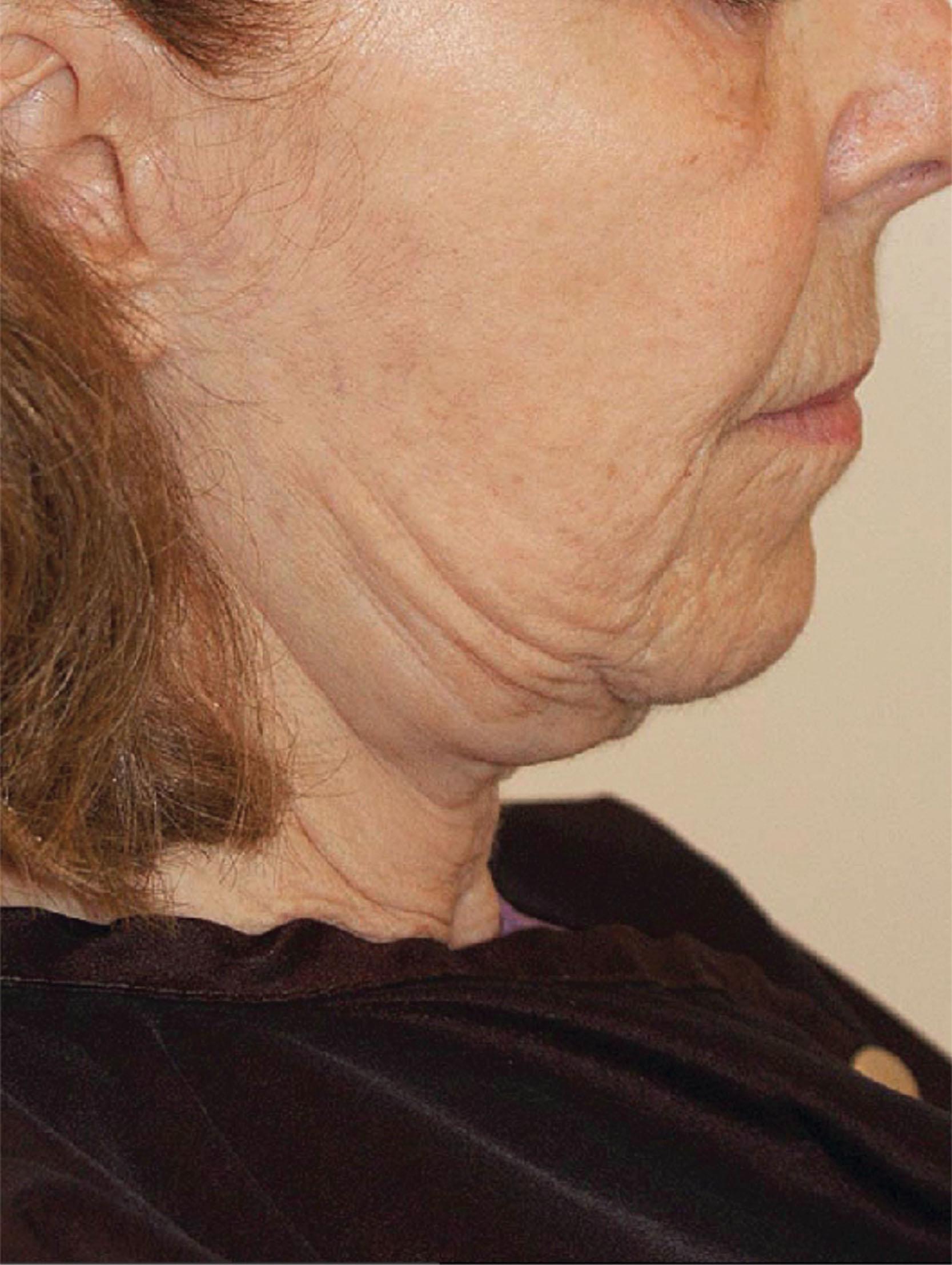
Lateral sweep is generally most apparent in the lateral view when the patient looks down. In this position lateral facial tightness is increased due to better tissue fixation and exaggerated SMAS support in the pre-auricular area, and the “sweep” appearance accentuated due to the comparatively poor or non-existent support of the more anterior-medial midface and lateral perioral areas.
Lateral sweep is an unavoidable eventual consequence of all traditional skin-lift, “mini-lift”, “low” SMAS, and deep plane and composite procedures that are not designed and carried out in a way that supports the midface and lateral perioral area. These skin-only and low deep layer procedures, are incapable of providing uniform support to both the anterior and lateral cheek, and are biogeometrically inclined to produce an unbalanced and unnatural appearance. A “high SMAS” flap in contrast, provides simultaneous and uniform one-flap support of the lateral facial, midface, and lateral perioral areas, and this results in a more balanced, comprehensive and natural rejuvenation, and minimizes the chance the lateral sweep will occur.
Lateral sweep can result when a high SMAS technique is used if the lateral perioral region is over-dissected subcutaneously and ligamentous attachments between the SMAS and the skin are inappropriately divided (see Fig. 9.8.25B,C ). These ligaments are the means by which the high SMAS flap supports the lateral perioral area, and over-dissection of this sort is a common error made by surgeons who erroneously assume that extended skin undermining will help improve the nasolabial fold. This is not a flaw in the technique, it is merely a failure to perform it correctly.

Recognizing the components of the aging change of the face and appreciating the underlying anatomical abnormalities is essential to properly advising patients and fundamental to the planning of any surgical repair. Careful analysis will reveal that most patient problems will fall into three broad categories: (1) aging and breakdown of the skin and skin surface; (2) facial sagging, skin redundancy, and loss of youthful facial contour; and (3) facial hollowing, atrophy and/or age-related lipodystrophy. Proper treatment will depend upon the types of problems present, the patient’s priorities, and the time, trouble and expense they is willing to endure to obtain the desired improvement.
Patients primarily concerned with surface aging of their face may not require formal surgical procedures and may achieve the type of improvement they desire through salon care and dermatologic surface treatments of the skin. These treatments include skin peels, skin resurfacing, dermabrasion, chemodenervation (neuromodulator injections), filler injections and various forms of cutaneous laser, radiofrequency, and other treatments designed to remove or reduce “age spots”, “spider veins”, wrinkles and other age-related skin surface imperfections.
Patients primarily concerned with facial sagging, skin excess and loss of facial contour will achieve minimal ultimate improvement, however, if surface treatments only are employed, and will require formal surgical lifts in which sagging tissue is repositioned and redundant tissue is excised if these problems are to be properly corrected and an attractive and natural-appearing improvement is to be obtained. The misapplication of surface treatments of the skin to the sagging face with excess tissue will produce little more than a smooth, saggy face with no improvement in contour. This sort of “smooth-saggy appearance”, typically seen in older patients who have undergone laser resurfacing or deep skin peels, is inconsistent with a natural look as patients with loss of facial contour generally also have concomitant skin surface aging. It is arguably more attractive and natural-appearing to have a well-contoured face with a few wrinkles and surface imperfections, than a smooth but saggy one.
Similarly, the misapplication of filler or fat injections to the sagging face with excess skin and an overly large skin envelope may produce a smoother face but at the same time an objectionably large, heavy, and unfeminine appearing one. One must also keep in mind that despite industry efforts to make us believe otherwise, fillers “lift” radially – that is in an outward direction – not vertically. Suggesting that fillers “lift” the face vertically may be one of the most deceptive and most thoughtlessly repeated mischaracterizations we make to ourselves and our patients.
Many, if not most, of the changes associated with loss of facial contour represent primarily “deep layer” problems that will be inadequately corrected with traditional “skin-only” or “low SMAS” techniques, however. Regrettably, many surgeons unfamiliar with deep layer techniques, and other physicians insufficiently trained to perform them, often perform “skin-only” facelifts or “mini-lifts”, and resort to misguided and misapplied ancillary procedures to overcome the shortcomings of these methods. These procedures include facial liposuction, malarplasty, submalarplasty, geniomandibular grove augmentation (“pre-jowl implant”), polytetrafluoroethylene (PTFE; “Gore-tex”) implantation, and various types of “thread lifting” and suspension suture placement. Although some of these procedures are at times useful and indicated, they will be unnecessary in the majority of cases if a high SMAS facelift and deep layer rejuvenation is performed ( Fig. 9.8.5 ).
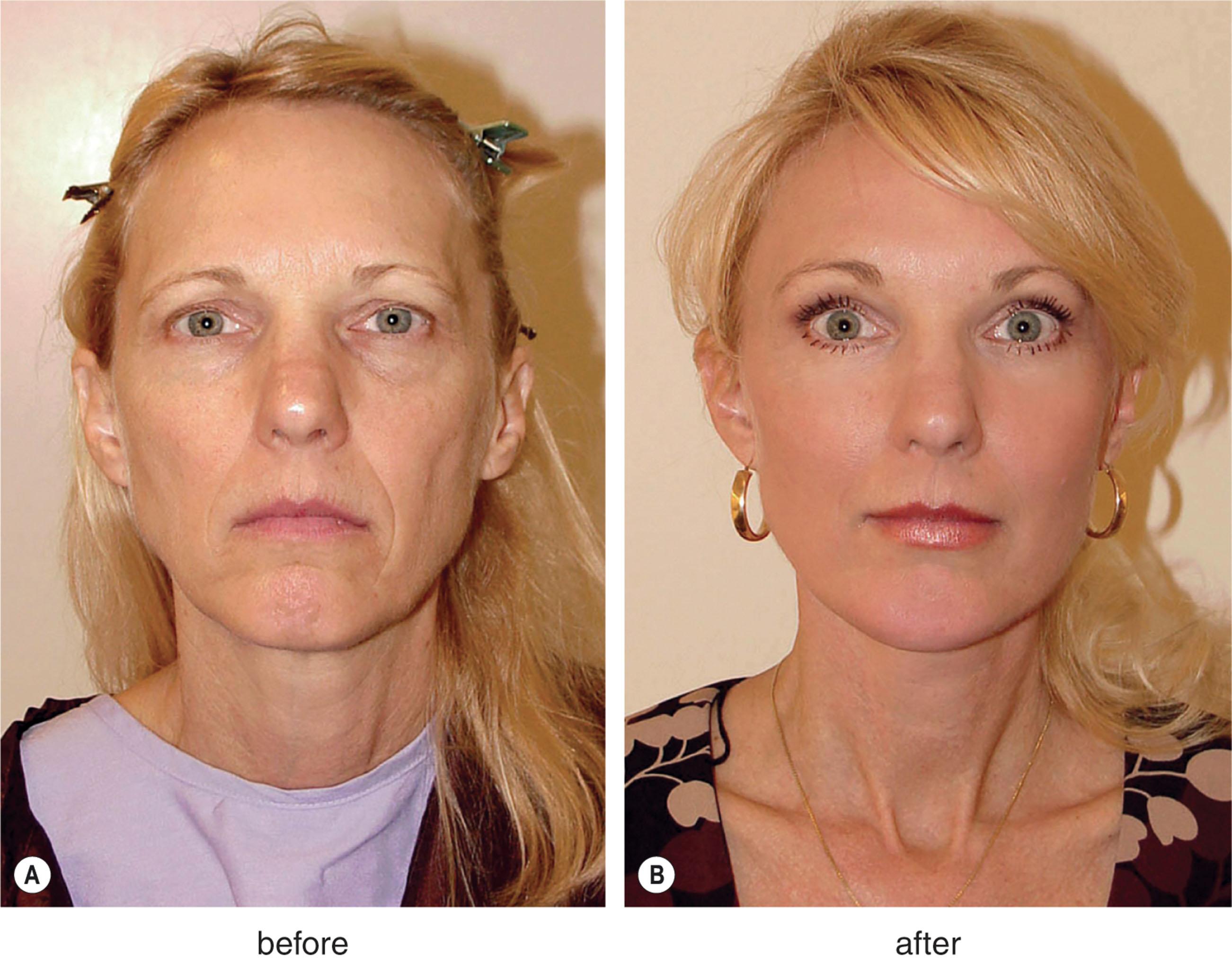
Patients with significant facial atrophy and age-related facial hollowing and loss of facial volume will generally achieve suboptimal improvement from both surface treatments of facial skin and surgical lifts. Smoothing skin will not hide a drawn and hollow appearance due to loss of facial volume, and it is difficult to create natural and attractive contours by lifting and repositioning tissues that have abnormally thinned with age. Restoring lost facial volume with autologous fat grafting is a powerful technique that has gained widespread acceptance. Properly performed, the addition of fat to areas of the face that have atrophied due to age or disease can produce a significant and sustained improvement in appearance unobtainable by other means. In addition, autologous fat grafting may represent the first true anti-aging therapy plastic surgeons have to offer in that there is a growing body of evidence that adult stem cells transferred with fat exert a regenerative effect on tissues in areas adjacent to areas where fat is injected, including overlying skin.
However, age-related facial atrophy rarely exists as an isolated event in the healthy patient, and thus patients troubled by it are not always logically or appropriately treated by fat grafting alone. Isolated fat grafting is also arguably of questionable benefit to the patient troubled by significant facial sagging and skin redundancy. Although aggressive filling of the sagging face with fat can produce improved contour and a smoother appearance, it generally results in an unusually large, overfilled face that appears both unnatural and unfeminine. Such an overfilled face is hard to correct in an attractive manner at a later date, and it is both more logical and practical to perform fat grafting in conjunction with formal surgical lifts if needed, or after ptotic tissue has been repositioned and redundant tissue has been removed. When a high SMAS technique is used in conjunction with fat grafting, both loss of facial contour and facial atrophy can be corrected and optimal improvement in the patient’s appearance can be obtained.
It is not possible to design or use a “universal” facelift technique as each patient will present with a unique set of problems that require precise anatomic diagnosis and an appropriately planned and individualized surgical repair. Committed study, careful planning, and avoiding the use of a “formula technique” will maximize improvement, limit complications, and minimize secondary irregularities.
The temporal portion of the facelift incision has traditionally been placed within the temporal scalp in a well-intended, but all too frequently counterproductive, attempt to hide the resulting scar. When cheek skin redundancy is small and abundant temple and sideburn hair is present, such a plan can sometimes be used without producing objectionable sideburn elevation and temporal hairline displacement. Patients best suited for this incision plan are usually younger and troubled by mild to moderate cheek laxity only. In many other situations, however, larger skin shifts and the presence of sparse temple hair can result in unnatural and tell-tale sideburn elevation and displacement of the temporal hairline if such a plan is used ( Fig. 9.8.6A,B ).
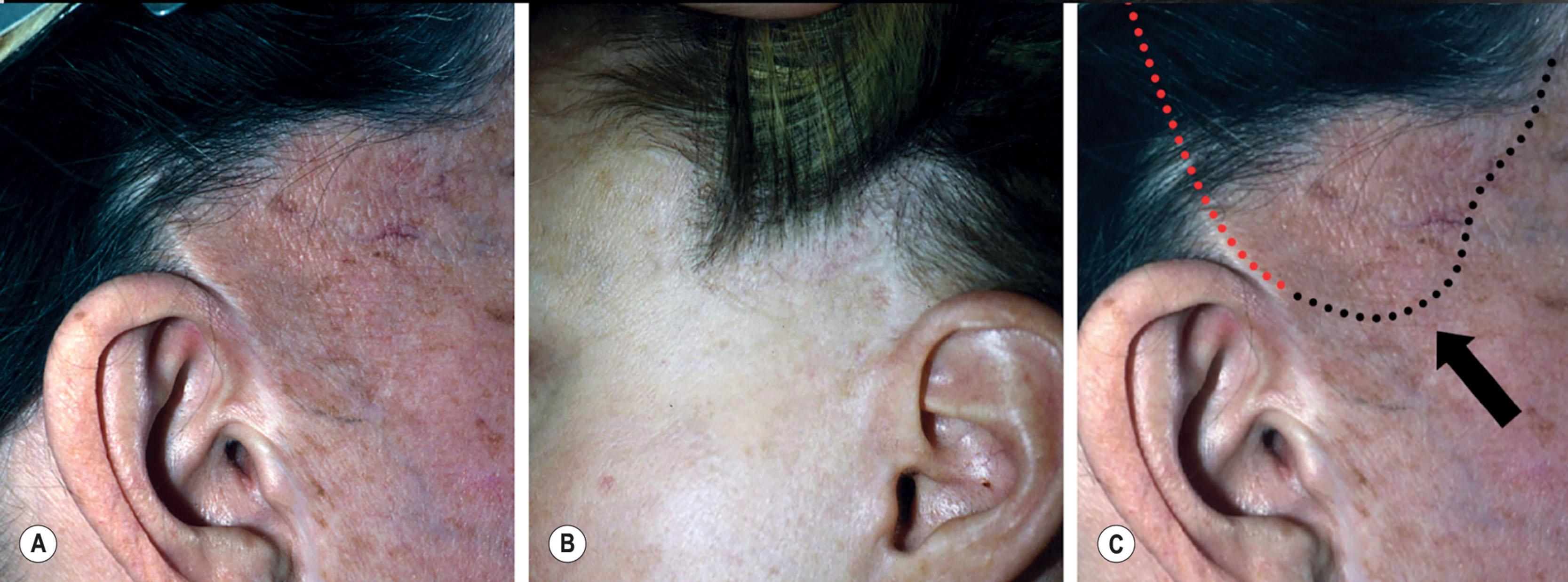
Proper analysis, careful planning, and the use of an incision along the hairline, when indicated, can avert this problem without compromising the overall outcome of the procedure ( Fig. 9.8.7A,B,C ).
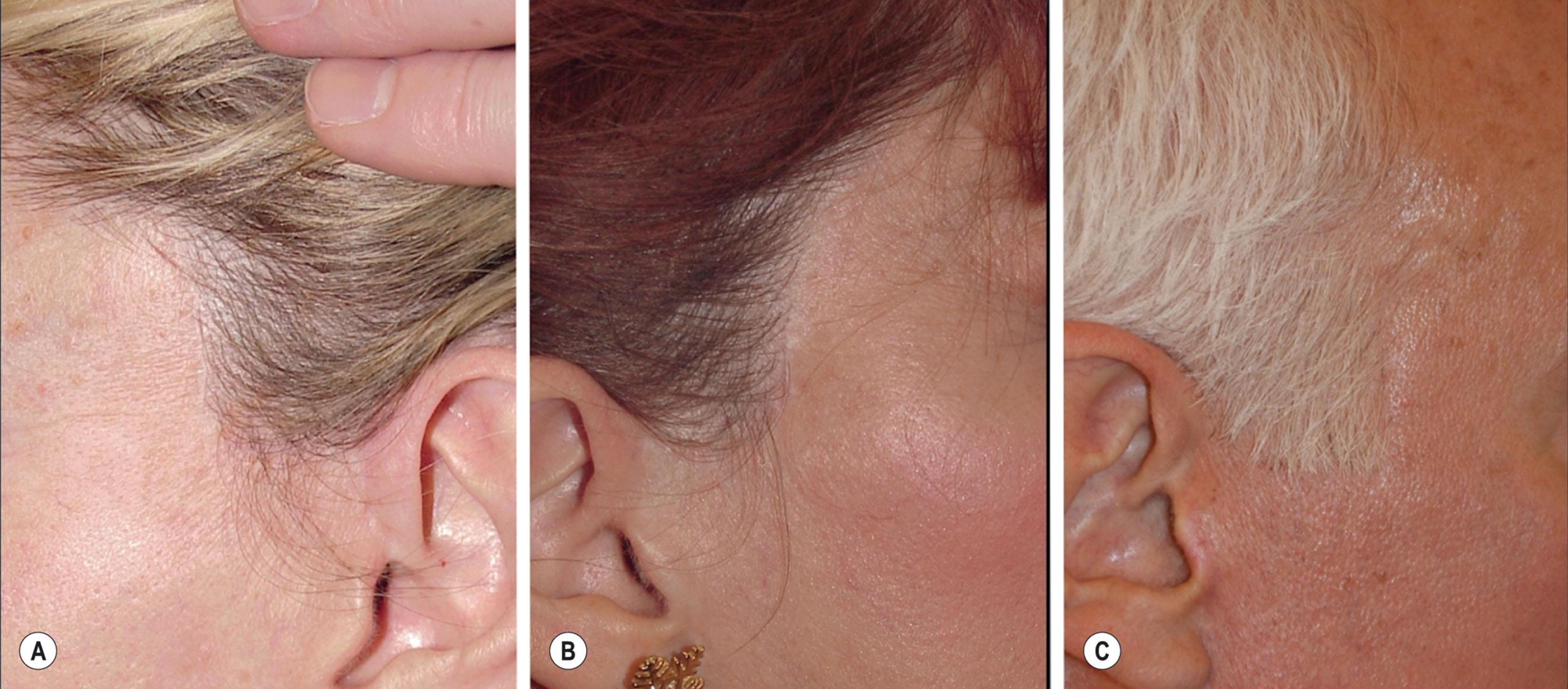
In appropriately choosing the location of the temporal portion of the facelift incision it is important to consider each patient’s particular circumstances including the amount of excess skin present over the upper lateral face and the skin shift that will occur when the facelift flap is lifted. This can be assessed by pinching up redundant skin and measuring it. The surgeon’s estimate of skin redundancy over the cheek, when considered in conjunction with an assessment of the amount of temple/sideburn hair present, allows rational selection of the best site for temporal incision placement ( Fig. 9.8.8 ).
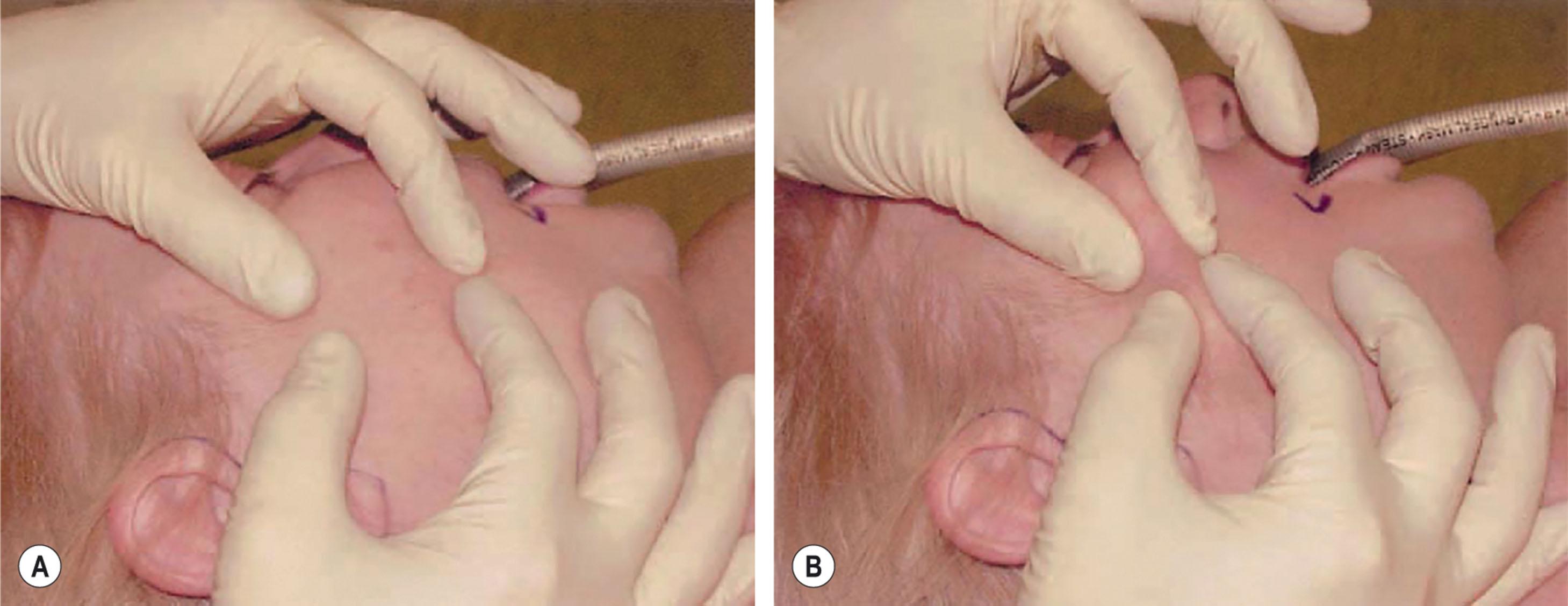
In patients in whom minimal or modest skin shift is predicted to occur and for whom abundant temporal scalp hair is present the temporal portion of the facelift incision can be placed in the traditional location 4–5 cm within the temporal scalp, extending superiorly up from the anterior-superior aspect of the ear ( Fig. 9.8.9 ). While individual circumstances will vary and the decision as to where the incision be placed should be based on the circumstances present and not arbitrarily based on age, typically patients in whom this incision plan is indicated are under 45 years old.
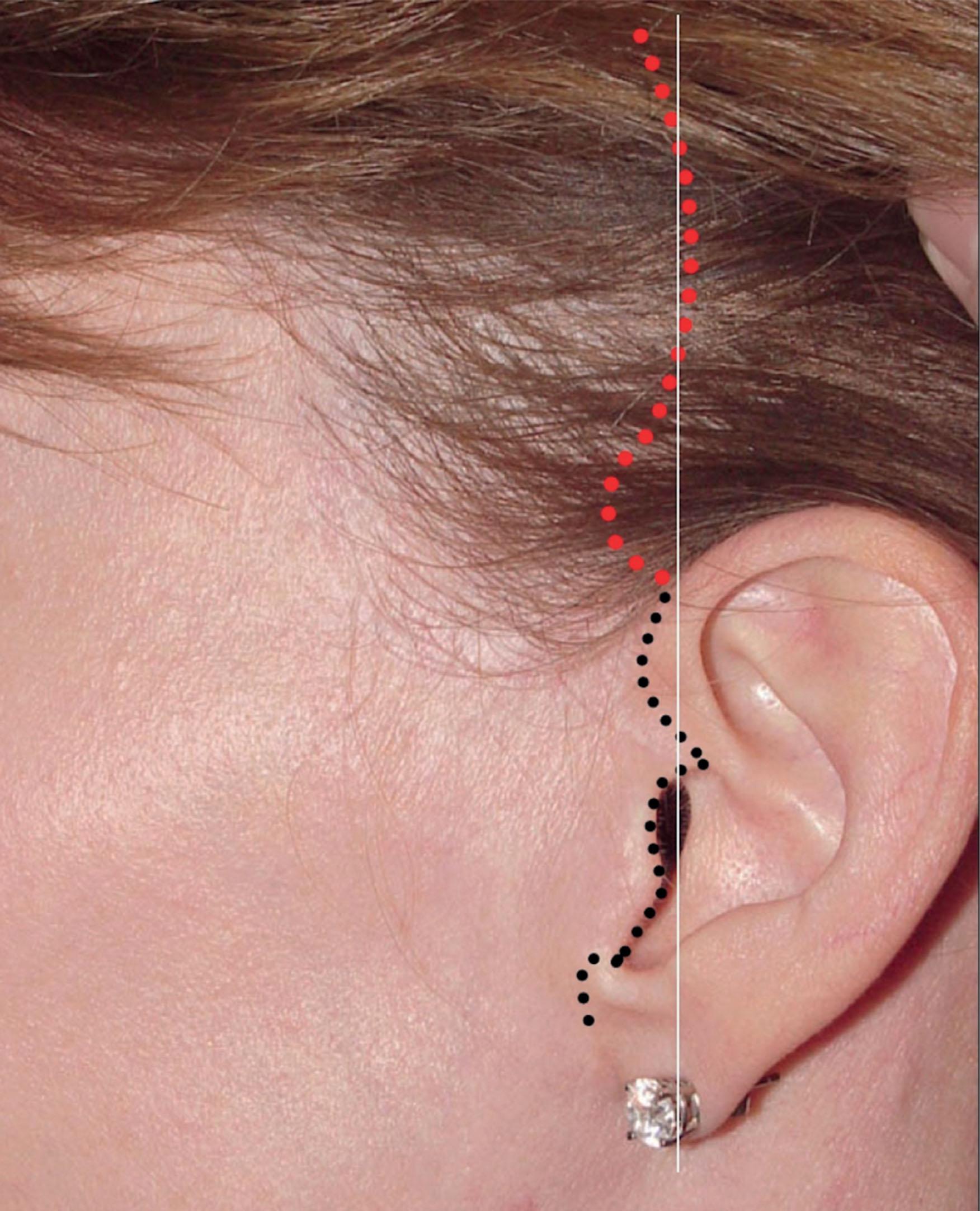
In patients in whom significant skin shift is predicted to occur and in whom the inferior margin of the temporal tuft of hair (“sideburn”) is predicted to be shifted above the junction of the ear with the scalp, and for whom more sparse temporal scalp hair is present, the temporal portion of the facelift incision should be placed along the hairline ( Fig. 9.8.10 ; see also Fig. 9.8.7 ) rather than within the temporal scalp. This incision plan will accommodate large posterior-superior skin flap shifts and allows maximum improvement in the upper lateral face to be made. If the incision is made with care and closed under no tension, the resulting scar is usually inconspicuous and will be far less troublesome for the patient than a displaced hairline (see Fig. 9.8.6 ). While individual circumstances will vary and the decision as to where the incision be placed should be based on the circumstances present and not arbitrarily based on age, patients in whom this incision plan is indicated are typically 45 years old, or older.
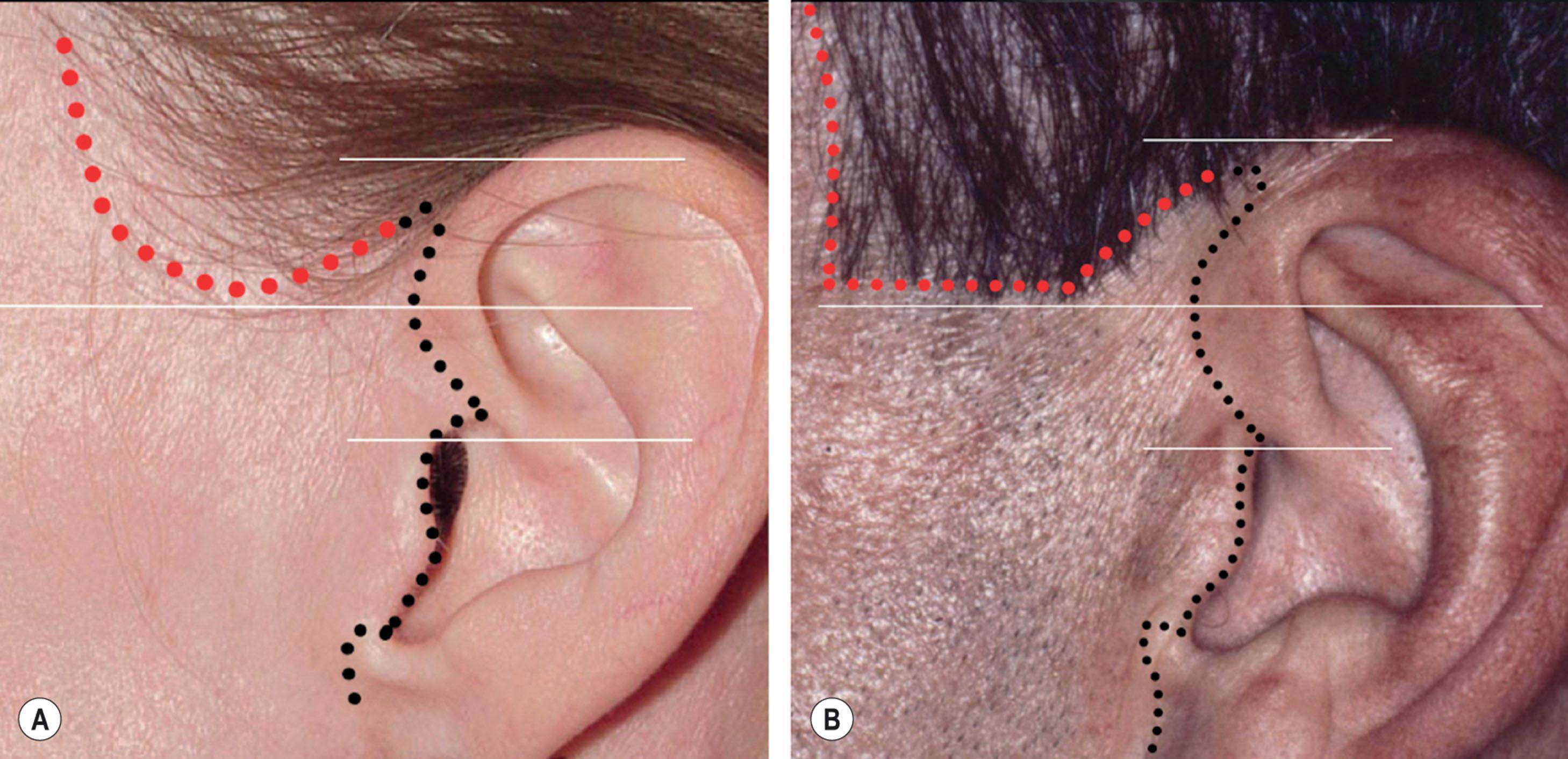
Options for the placement of the temporal portion of the facelift incision should be discussed with any patient in whom significant displacement of the temporal hairline or elevation of the sideburn might occur. Incision placement is best presented as a choice between two imperfect alternatives and it is wise that the final decision as to where the incision will be located be left to patient after appropriate discussion has been made. In all, it has been our experience that most patients are disturbed by the prospect of temporal hairline/sideburn displacement and recognize it as a tell-tale sign that a facelift has been performed. When properly counseled and given the choice, most will readily consent to an incision along the hairline.
Open to inspection, the pre-auricular region exists as a frequent point of reference for those seeking to identify a facelift patient and in essence arguably comprises the surgeon’s “signature” (or lack thereof) of their work. Traditionally, incisions in this area are made well anterior to the anterior border of the helix and continued inferiorly, anterior to the tragus ( Fig. 9.8.11A ).
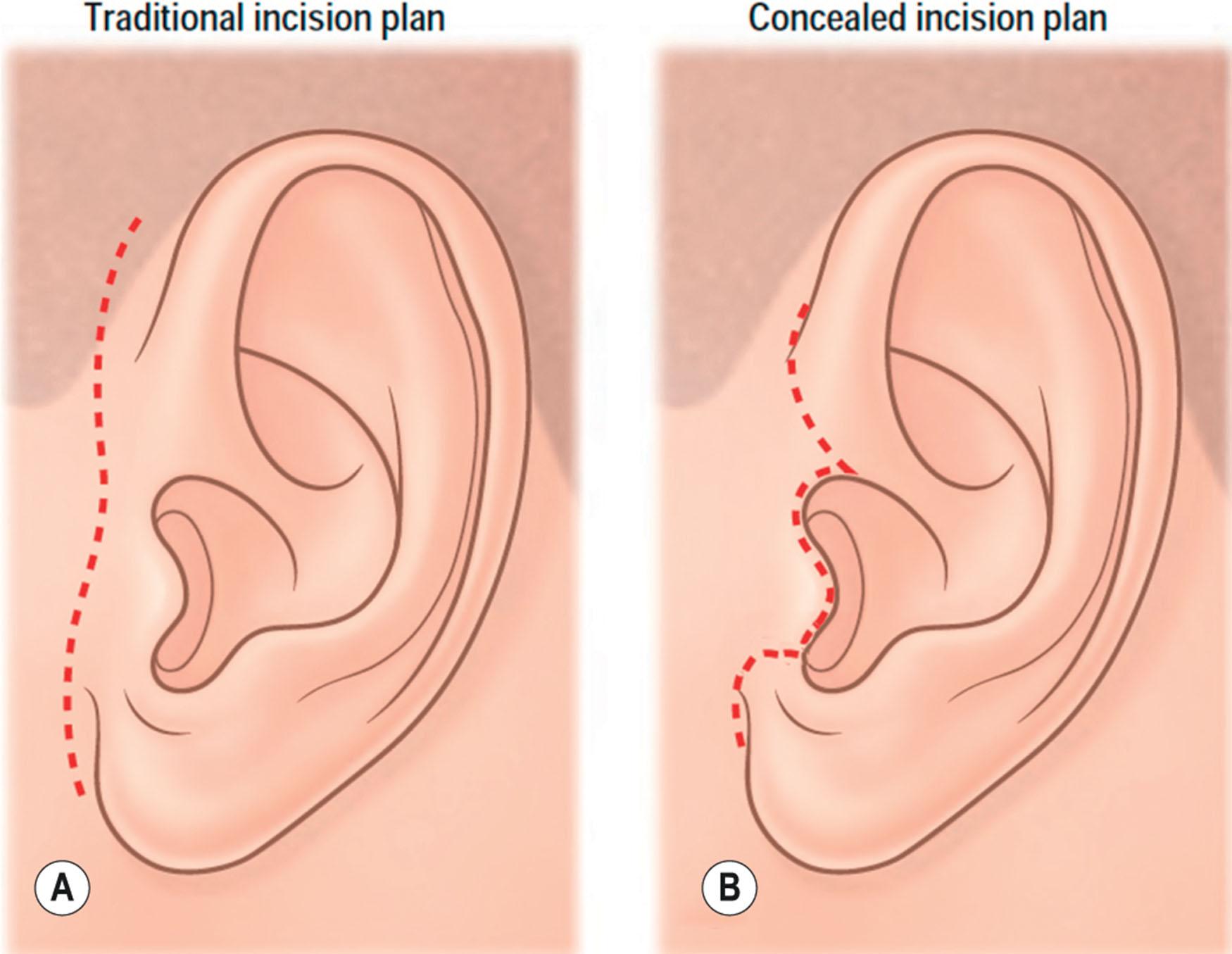
This plan, however, works well only for the unusual patient with cheek and tragal skin of similar characteristics who, in addition, exhibits favorable healing. Unfortunately, most patients have a marked gradient of color, texture, and surface irregularities over these areas and a tell-tale mismatch will be evident, even in the presence of an inconspicuous scar. For these reasons, and in all but the unusual case (secondary and tertiary procedures in patients with minimal or no skin excess), the pre-auricular portion of the facelift incision should be precisely placed along the posterior margin of the tragus, rather than in the pretragal sulcus ( Fig. 9.8.11B ). In this location a mismatch of color, texture, or surface irregularities will not be noticed and the scar, if visible, will appear to be a tragal highlight ( Fig. 9.8.12 ; see also Fig. 9.8.17 ).
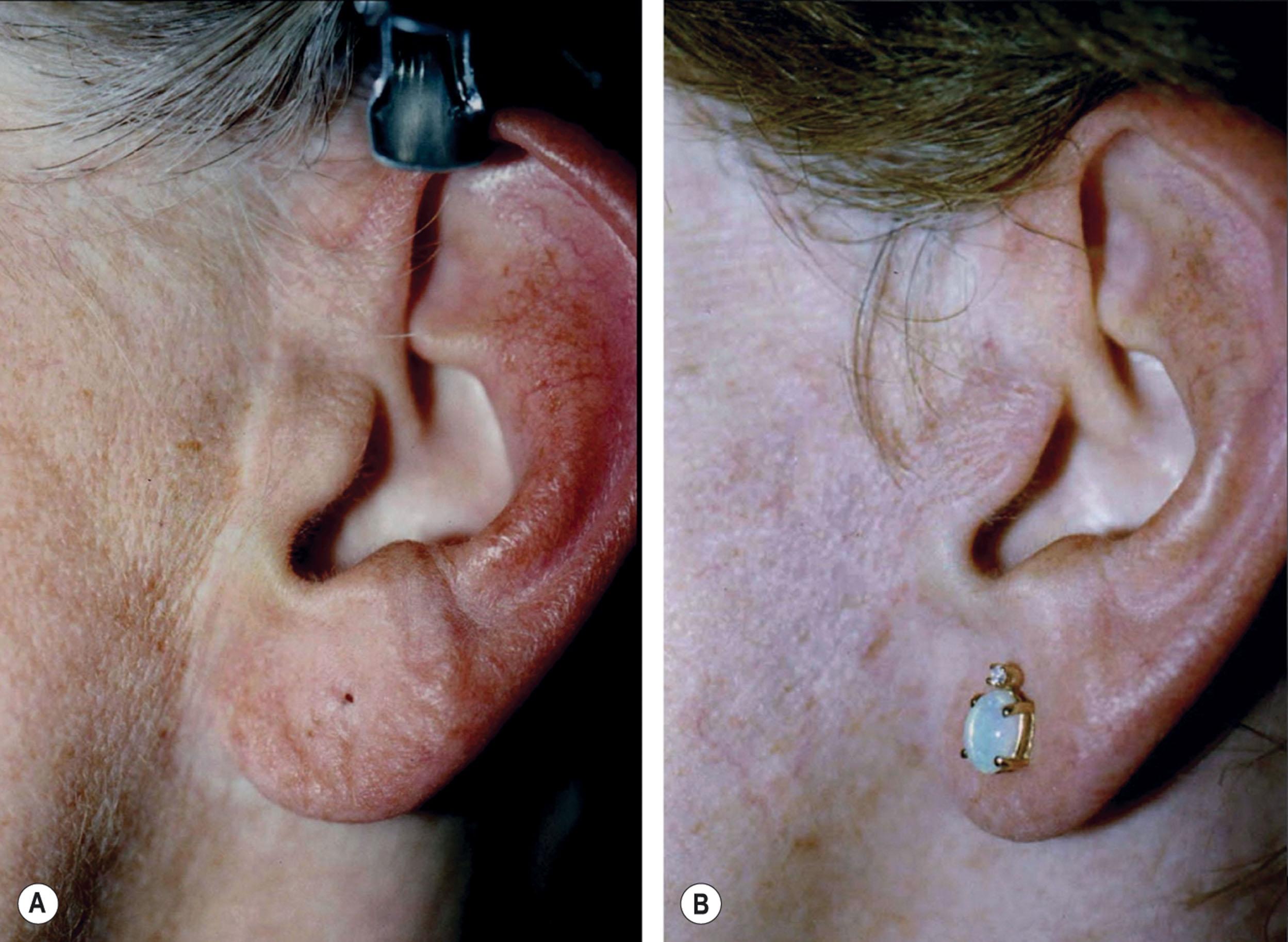
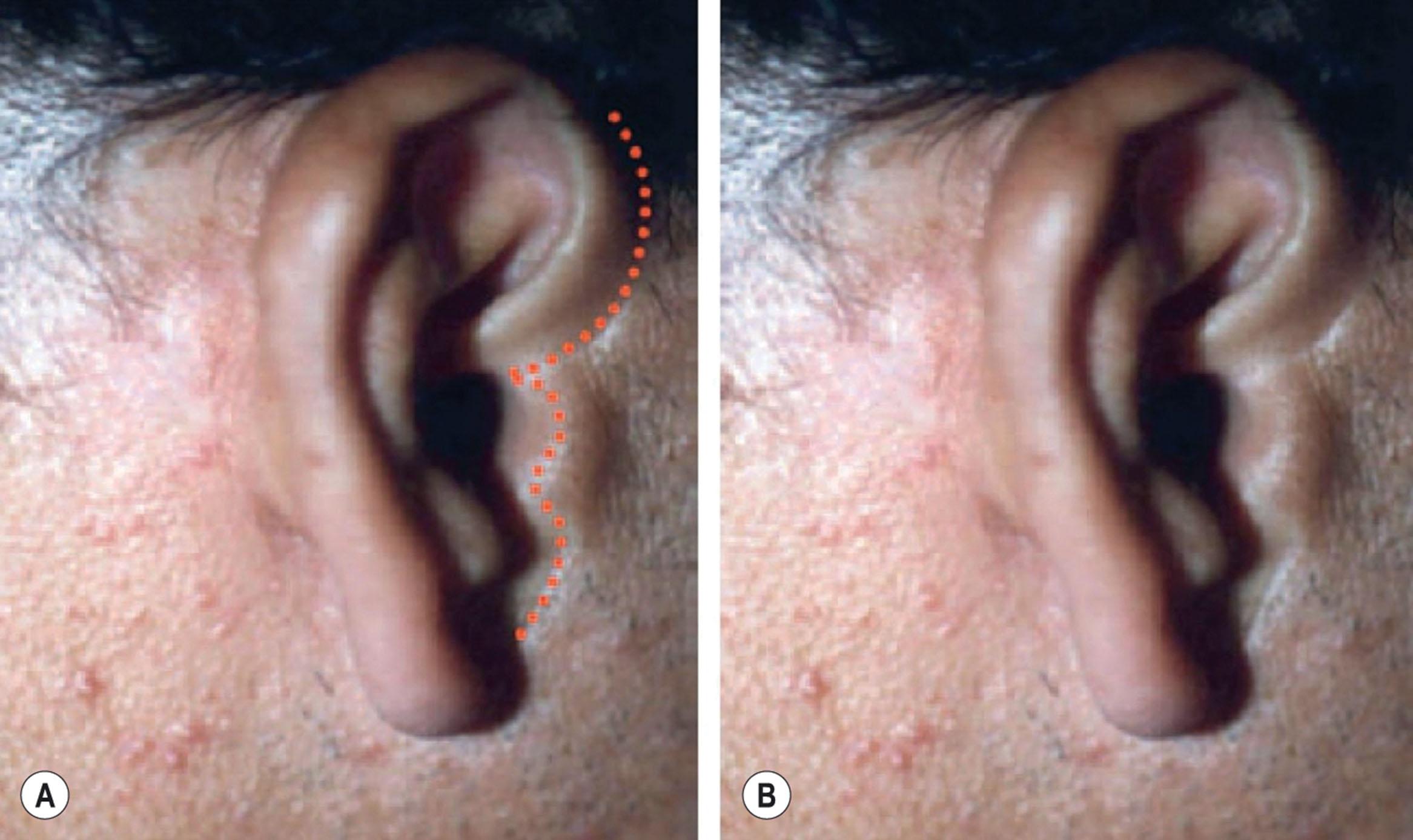
In addition, a properly planned and executed incision along the margin of the tragus will not produce tragal retraction or other anatomical irregularity ( Figs. 9.8.13 & 9.8.14 ).
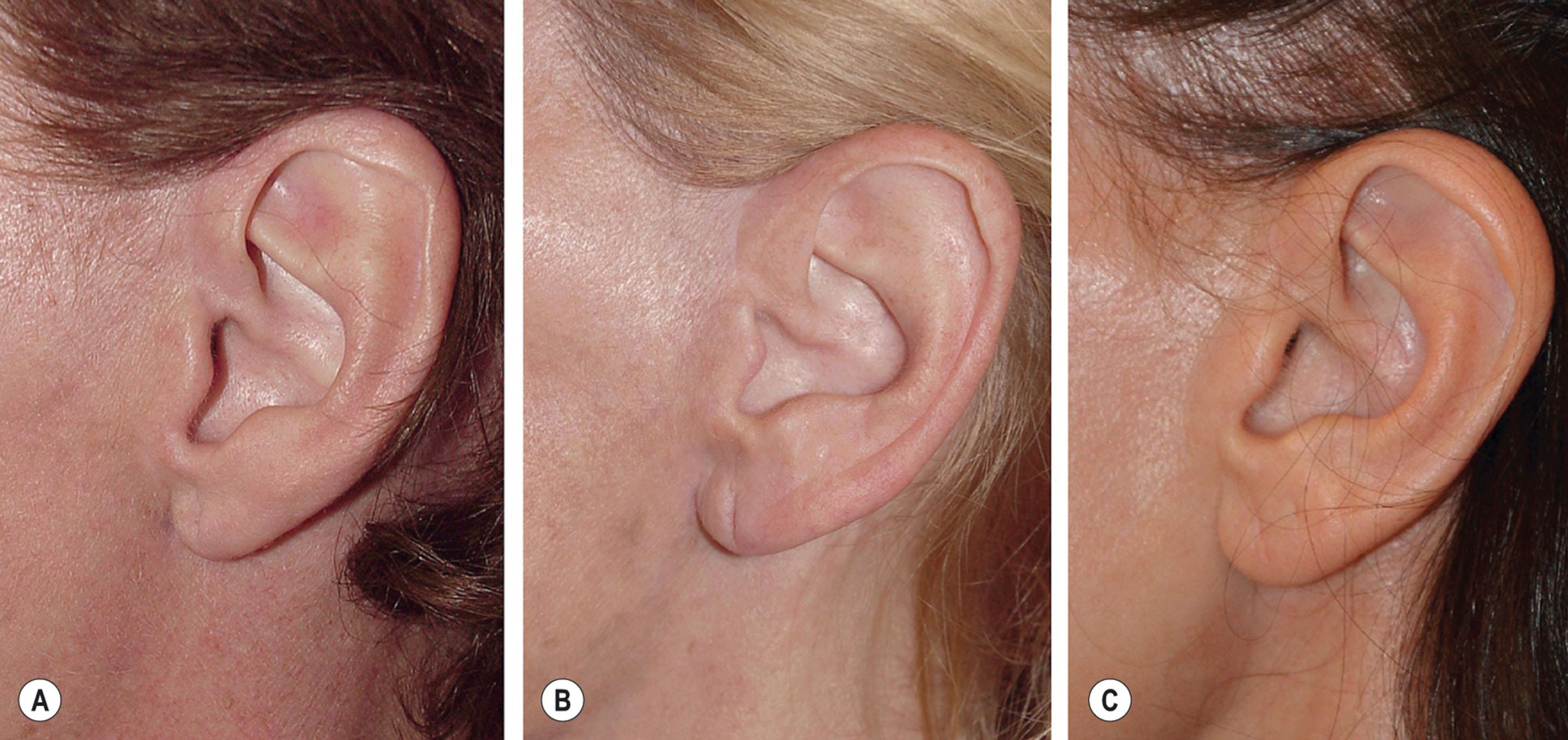
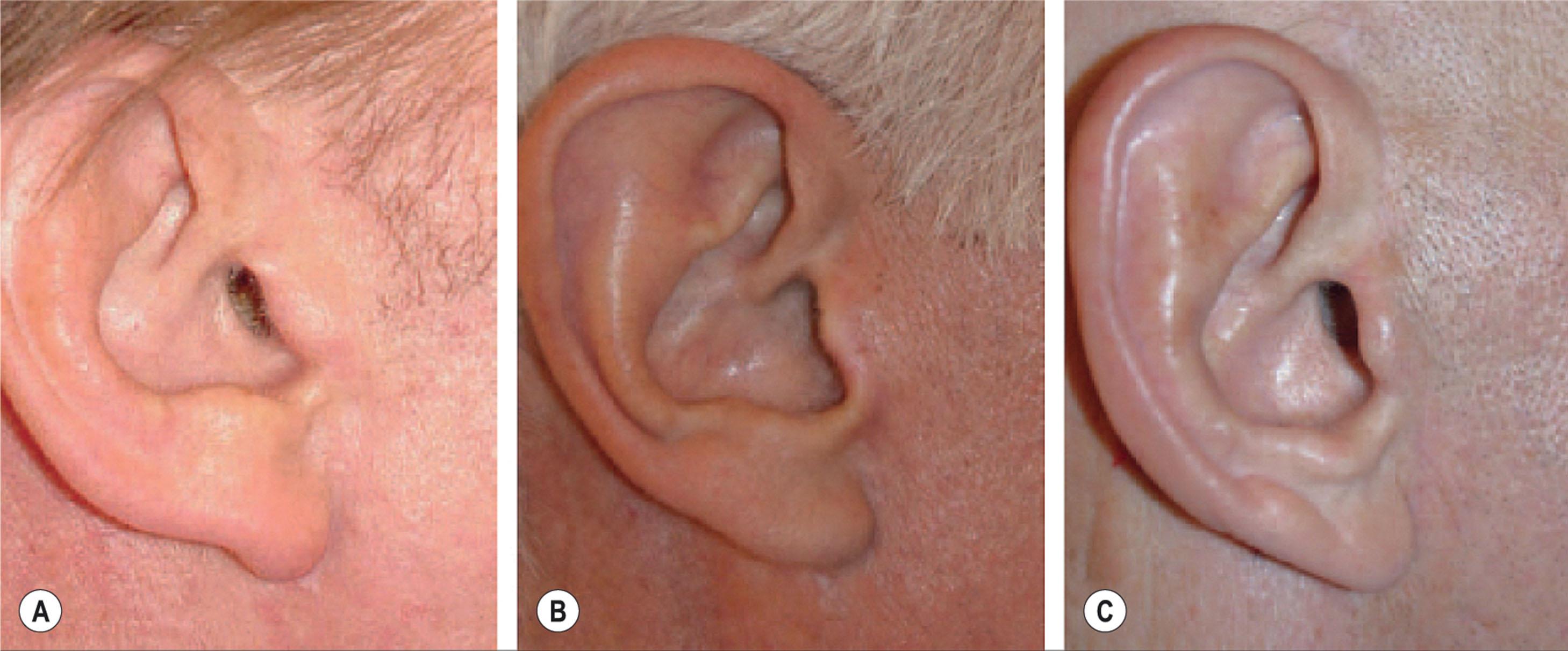
In the male patient a similar incision plan is used. In many cases skin flap shifts will be such that beard hair will not be retro-posteriorly displaced enough to be advanced onto the tragus itself. In cases where larger skin flap shifts occur, the tragus can be kept free of beard hair when a retrotragal incision is used by intra-operative destruction of beard follicles from the underside of the tragal flap when indicated ( Fig. 9.8.14 ; see Chapter 9.11 , Fig. 9.11.35 Male facelift).
The pre-auricular incision consists of three component incisions: (1) a prehelical incision; (2) the tragal incision; and (3) a prelobular incision. Careful attention to the planning of each must be undertaken if a well-concealed scar and natural appearance is to be obtained.
The superior, prehelical portion of the pre-auricular incision should be planned as a soft curve paralleling the curve of the anterior border of the helix. This will result in a natural-appearing “width” to the helix in keeping with the rest of the ear and the resultant scar, if visible, will appear to be a helical highlight and/or the natural anatomic transition from smooth pinker skin of the helix to the paler, coarser skin of the cheek ( Fig. 9.8.15 ).
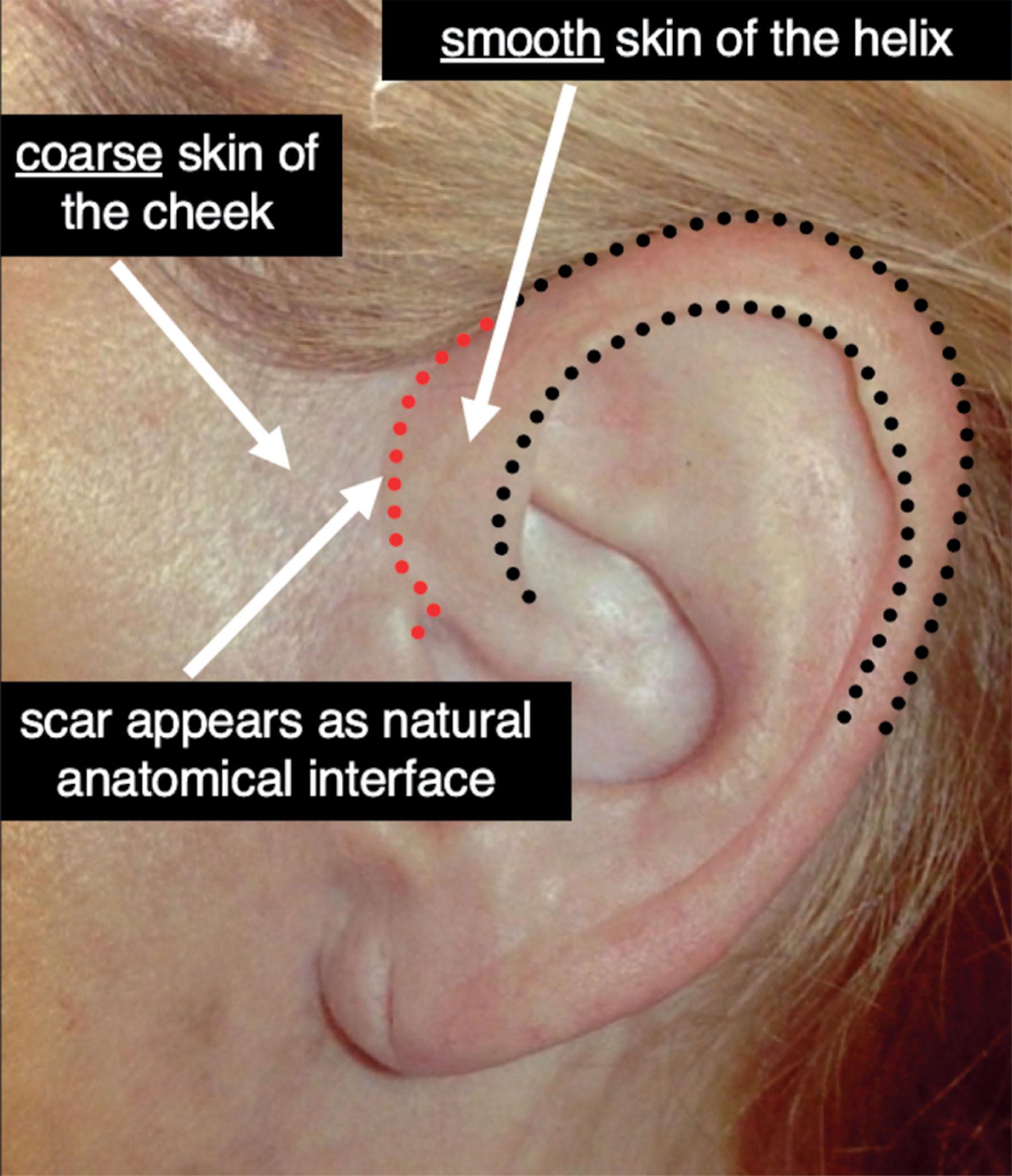
If the prehelical portion of the pre-auricular incision is placed too far anteriorly or is situated so that it encroaches on the helix itself, the illusion of the scar as an anatomic interface and/or reflected highlight is lost ( Fig. 9.8.16 ).
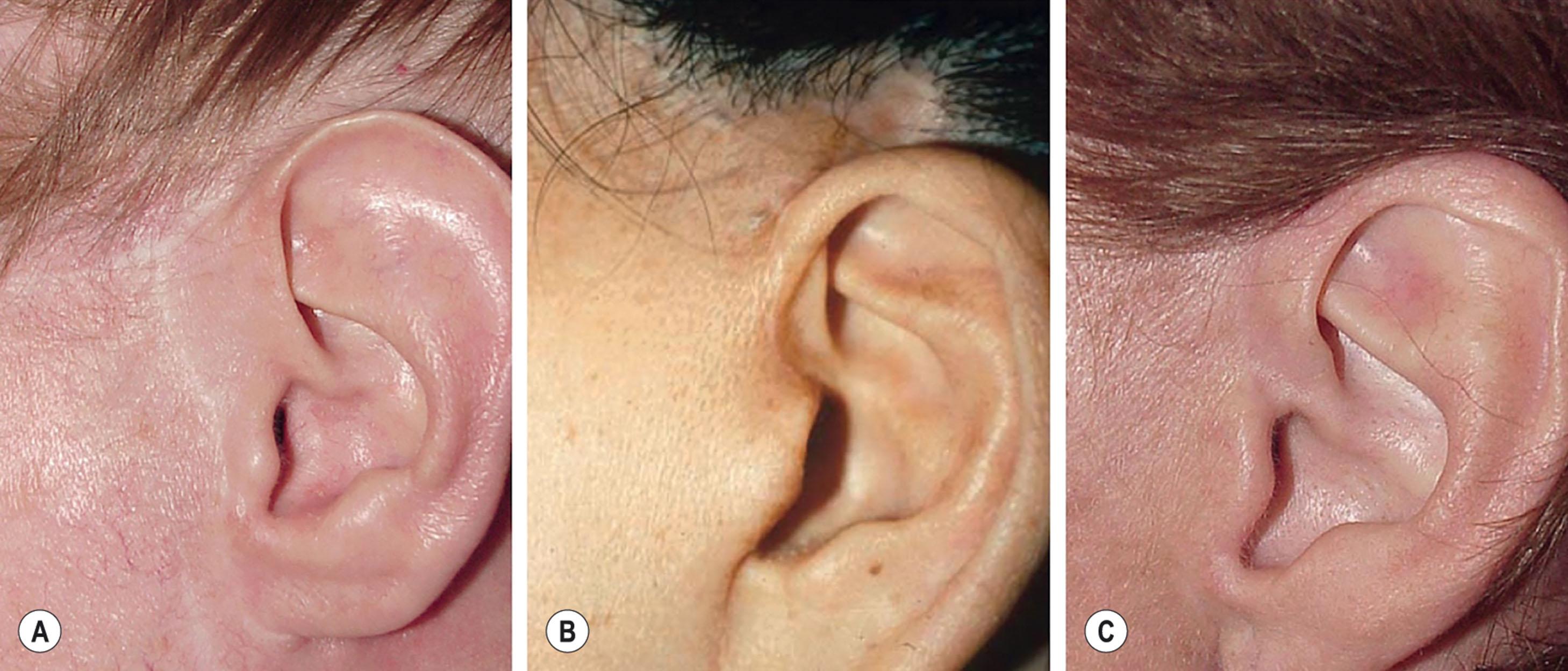
As the tragus is approached, the mark for incision is carried into the depression superior to it and then continued along its posterior margin . In this location the scar, if visible, will appear to be a natural highlight ( Fig. 9.8.17 ).
At the inferior portion of the tragus the incision must turn anteriorly and then again inferiorly and a right angle, into the crease between anterior lobule and cheek. If a more relaxed plan is made, or if a straight line or “lazy S” incision plan is used, skin settling and scar contraction will result in crowding of the incisura, obliteration of the inferior tragal border, and a tell-tale elongated and “chopped-off” tragal appearance ( Fig. 9.8.18A,B ).
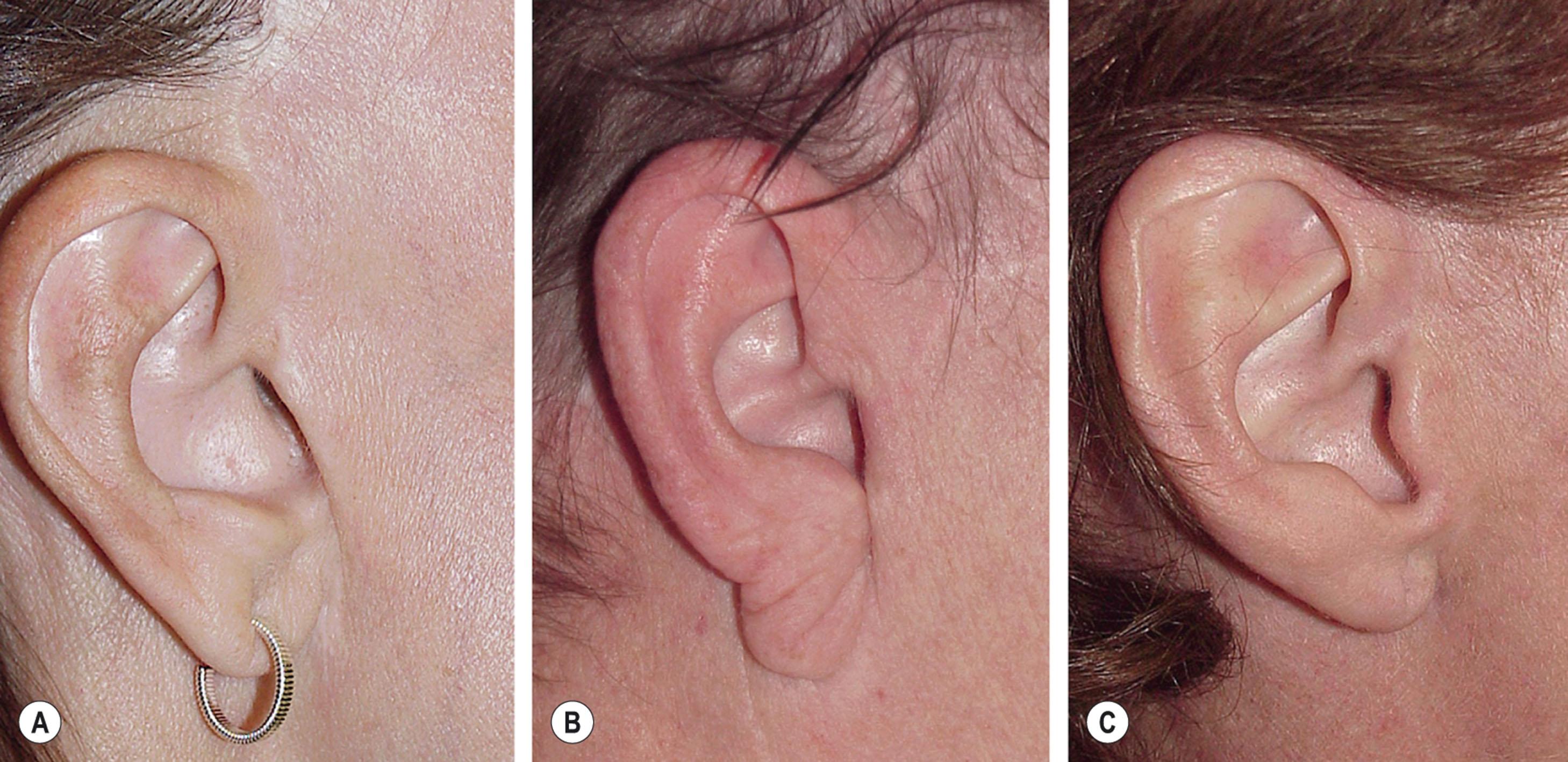
To obtain a natural perilobular appearance, it is essential in cases where a naturally shaped earlobe is present to preserve the natural sulcus between the earlobe and the cheek and to avoid destruction of or excision of this and aesthetically important anatomic subunit. This is accomplished by marking the incision 1–2 mm inferior to this junction in women and 2–3 mm inferior to it in men. Placing the incision slightly more inferiorly in men facilitates shaving postoperatively should bearded skin be shifted superiorly against the incision as it commonly will be. In both cases, when a naturally shaped lobule is present, all other factors being equal, a superior result will be obtained when such a plan is used, in comparison to any plan in which the incision is placed directly in the sulcus and an attempt is subsequently made to directly join thin, soft earlobe with coarse, thick cheek.
The “postauricular” portion of the facelift incision is actually composed of three component incisions: (1) a postauricular incision extending in and along the concho-mastoid sulcus (see Fig. 9.8.20D , gray dotted line); (2) a transmastoid component incision traversing horizontally across the mastoid to the occipital scalp (see Fig. 9.8.20D red line); and (3) an occipital incision extending into the occipital scalp or along the occipital hairline (see Fig. 9.8.20D , white dotted line). A careful consideration of the design of each is important if an overall well-concealed and inconspicuous scar is to be obtained.

Traditionally, the conchomastoid portion of the facelift incision has been made up onto and over the posterior surface of the concha. This was done as part of a well-intended effort to offset inevitable descent of the postauricular skin flap and inferior migration of the resulting scar that occurred when skin was forcefully advanced superiorly in a misguided attempt to improve neck contour by skin flap tightening. Experienced surgeons have since come to realize that such a plan embodies a number of erroneous assumptions and can result in many undesirable effects including hypertrophic scarring, postauricular webbing, and obliteration of the auriculomastoid/conchomastoid sulcus.
The postauricular portion of the facelift incision should instead be marked directly in the existing auriculomastoid (conchomastoid) sulcus in women, and 2–3 mm posterior to it in men. Placing the incision 2–3 mm posterior to the sulcus in men prevents advancement of bearded skin against the concha and facilitates shaving in this area. Such a plan places the scar along or near a natural anatomical interface where it will be difficult to detect, even on close inspection (see Fig. 9.8.25 ). Marking must be made with the ear resting near its natural anatomic position. If the ear is pulled forward while marks are made, mastoid skin will be pulled anteriorly over the posterior surface of the concha and the incision will end up posterior to its intended location and outside the auriculomastiod sulcus . Incorrect marking in this manner is one of the most common causes of a poorly situated postauricular (conchomastoid) scar.
Considerable confusion exists among surgeons performing facelift procedures as to what level the transmastoid part of the postauricular facelift incision should cross over to the occipital scalp and, as a result, this part of the incision is often not placed strategically and in a manner that best conceals it, or in a way that allows optimal excision of skin from the anterior neck to be performed. If it is placed too low it will be visible when the patient’s hair is worn up or if they wear a short hairstyle. If it is placed too high the defect created will force and overly vertical shift of the postauricular skin flap and compromise improvement in the anterior neck and submental region ( Fig. 9.8.19 ). Fortunately, if one assesses the goals sought and employs simple logic in meeting them, rational and effective transmastoid incision placement becomes possible.

A useful guide in siting the transmastoid part of the postauricular incision is to envision a horizontal line through the point at which the anterior and superior crus of the anti-helix diverge. Typically at that level the outer rim of the helix extends posteriorly back to the occipital hairline to the so-called “helix-hairline touch point” and a transmastoid incision placed at that level will be hidden behind the ear in the lateral view ( Fig. 9.8.20 ).
Planning the location for the occipital portion of the postauricular incision is conceptually similar to that of the temple region and the incision plan must take into account and address similar concerns of hairline displacement and scar visibility. Traditionally this incision is arbitrarily placed low transversely, into the occipital scalp, in a well-intended but almost always counterproductive attempt to hide the resultant scar ( Fig. 9.8.21A ).
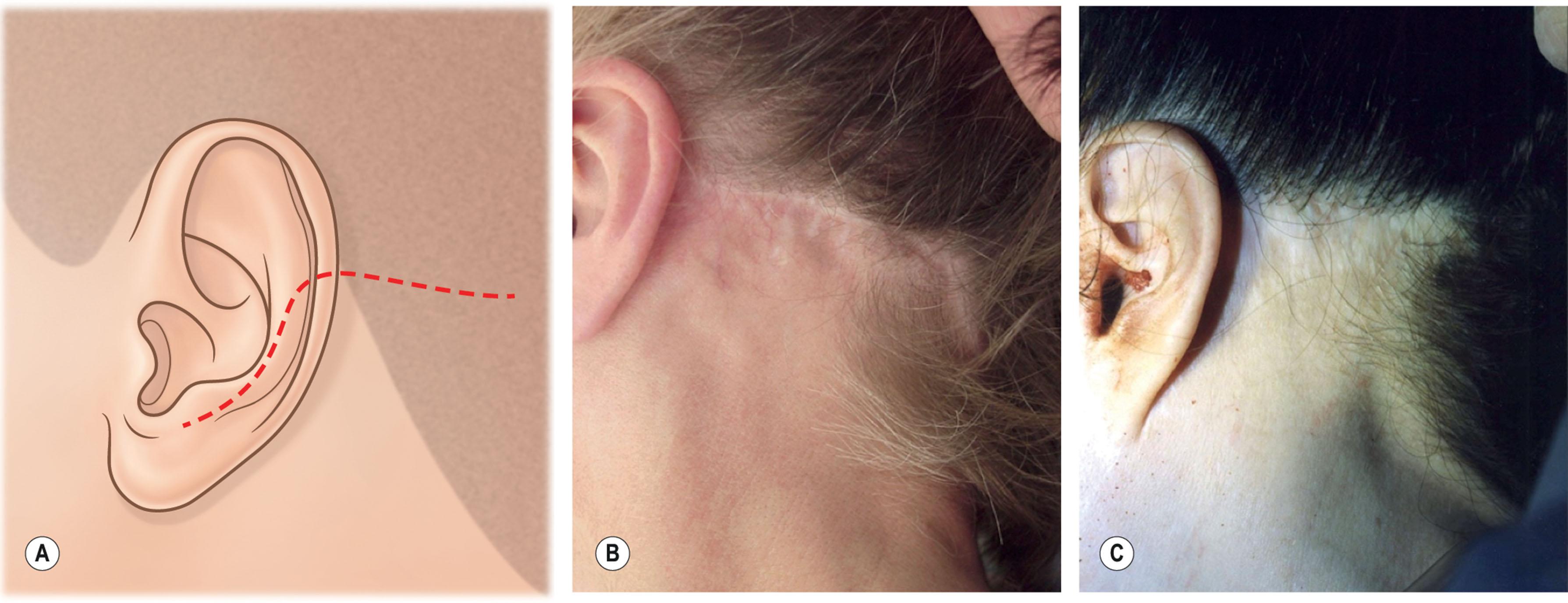
Regrettably, many other conceptually flawed, similar incision plans, which do not recognize the tissue biogeometry of the postauricular area or provide for skin excision along a useful vector, have been advocated. A thoughtful consideration of what one is trying to accomplish, however, allows one to employ incision plans that are logical and effective.
For patients in whom neck skin redundancy is small and shifting and excision of postauricular skin is unnecessary, a traditional postauricular incision plan (as shown in Fig. 9.8.21A ) is appropriate if its transmastoid portion is situated superiorly enough to be concealed behind the ear (see preceding discussion) and will result in a well-concealed scar. Patients in this category are usually young and troubled by mild neck deformity only, and in these situations the incision is used for access to the lateral neck only, and not as a means to remove postauricular skin . Mistakenly using this incision to excise skin along a posteriorly directed vector will predictably result in the advancement of neck skin into the occipital scalp and “notching” of the occipital hairline ( Figs. 9.8.21 and 9.8.22A,B ). Similarly, using this incision to excise skin along a superiorly directed vector will predictably result a wide transmastoid scar ( Fig. 9.8.23 ). Skin excision along either vector using this incision is conceptually flawed and the source of all-to-common secondary facelift irregularities.
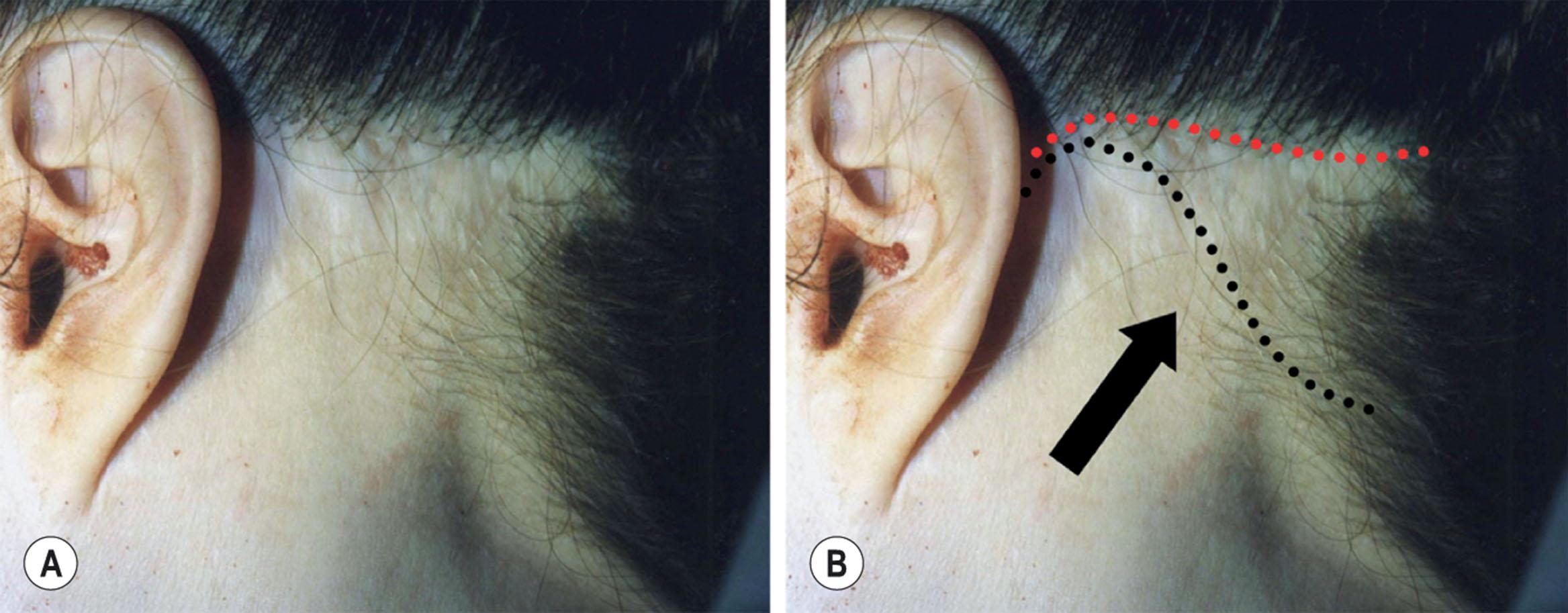
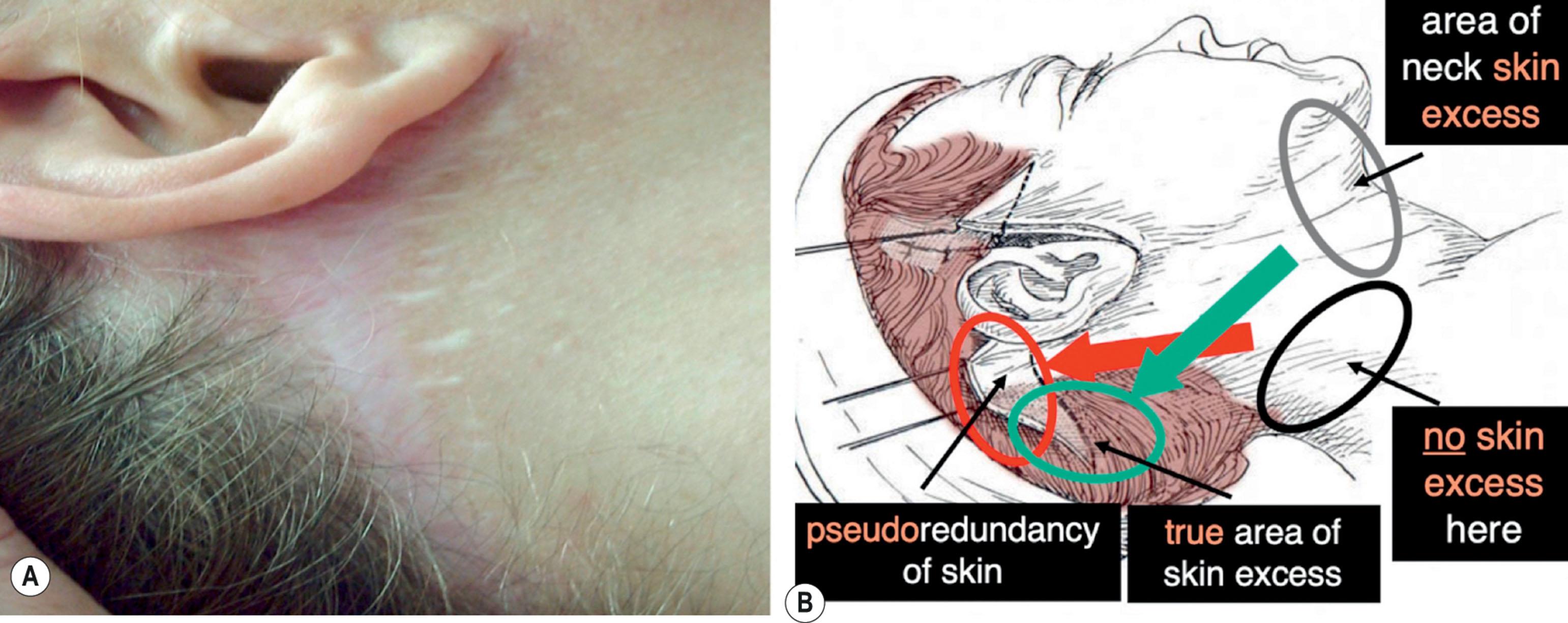
Although not all patients and their surgeons will recognize these irregularities for what they are, most are nonetheless aware an unnatural appearance is present, especially those patients who wear short hairstyles, wear their hair up or back, or who lead active lives and engage in activities that may displace camouflaging wisps of remaining hair. Proper analysis, careful planning, and the use of an incision along the hairline ( Figs. 9.8.24 & 9.8.25 ), when indicated and carried out in a technically correct manner, will prevent this problem, and allow skin to be excised along a correct posterior-superior vector, while simultaneously producing a well-concealed scar ( Fig. 9.8.25 ; and see also Fig. 9.8.20A ).
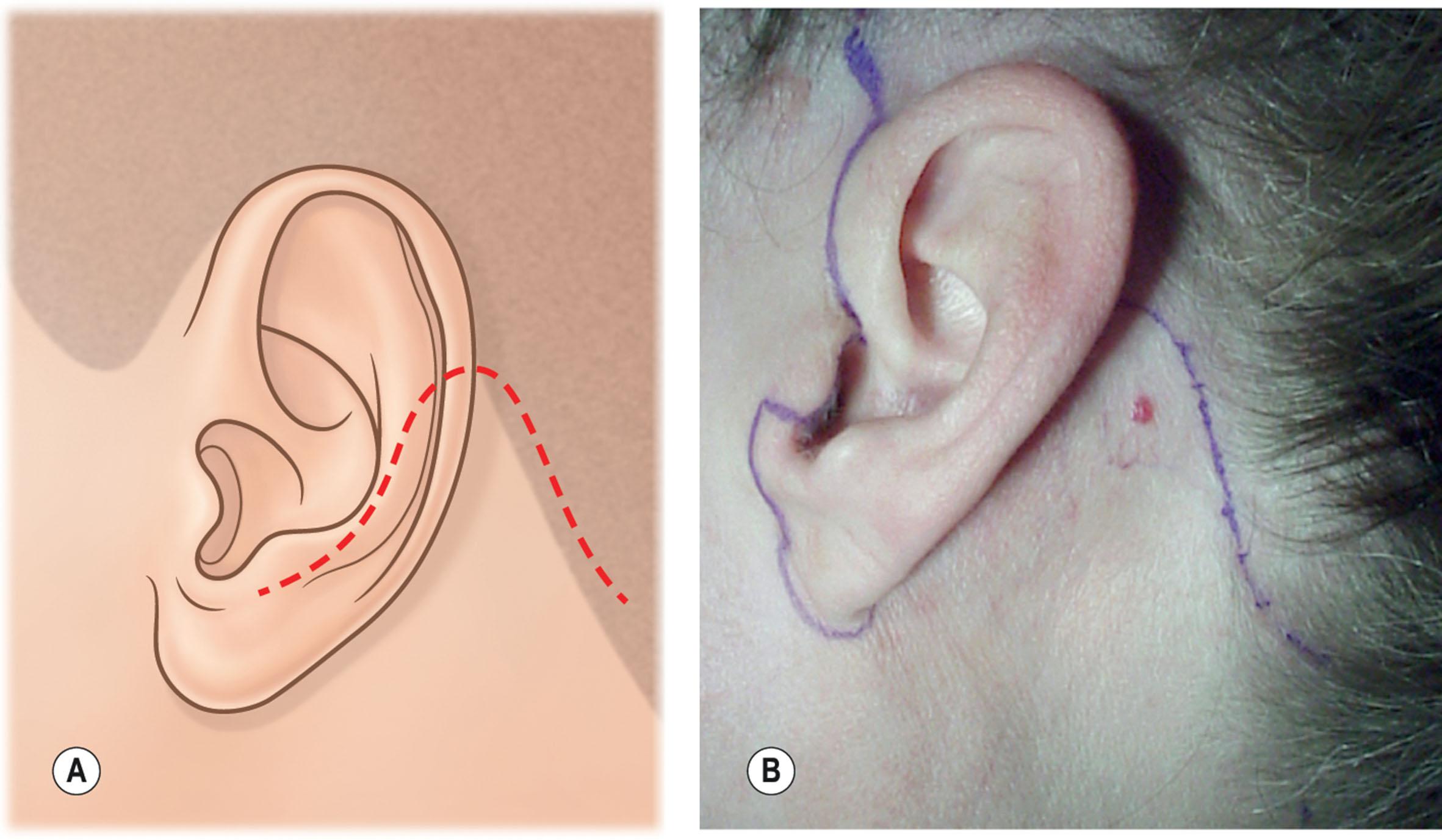
In logically designing and deciding upon the position of the occipital portion of the postauricular incision one must gauge the skin redundancy along the predicted posterior-superior direction of flap shift. This can be accomplished by pinching up tissue over the upper lateral neck and estimating the amount present. If 2 cm or less of excess neck skin is present, a “traditional” incision over the mastoid extending posteriorly into the scalp at the level of the mid-ear (see Fig. 9.8.21A ) will, in most cases, not result in objectionable disruption of the occipital hairline. Typically this incision plan will be used in patients under 40 years old. If more than 2 cm of neck skin redundancy is present, however, the incision should be placed along the occipital hairline but designed in such a manner that a tell-tale scar will not be visible in front of the fine hair on the nape of the neck (see Figs. 9.8.24 & 9.8.25 ). This incision plan is typically needed in patients over 40 years old if hairline displacement is to be avoided and neck skin is to be excised along a proper and useful vector.
The length of the occipital portion of the postauricular incision will necessary vary depending on the quality of the patient’s tissues and the amount of redundant skin present in the anterior neck and submental area (size of “wattle”), and “ small,” “medium,” and “long” (length of incision along the occipital hairline) incision plans are used as indicated (see Fig. 9.8.26 ). In patients with good tissue quality and minimal anterior neck and submental skin excess (“small wattle”), a “short” incision along the hairline will be indicated ( Fig. 9.8.26A ). In patients with modest loss of skin quality and modest anterior neck and submental skin excess (“medium wattle”), a “medium”-length incision is made along the occipital hairline ( Fig. 9.8.26B ). In elderly patients with poor skin elasticity and a large anterior neck and submental skin excess (“large wattle”), a “long” incision along the occipital hairline will be needed ( Fig. 9.8.26C ).

As is the case with temporal incision placement, options for the placement of the occipital portion of the postauricular incision should be discussed with the patient preoperatively and presented as a choice between two imperfect alternatives: a scar “hidden” in the occipital scalp but with hairline notching and displacement; or a scar along the hairline but with hairline preservation. It is wise that the final decision as to where the incision will be located is ultimately left to the patient, after the advantages and disadvantages of each have been thoroughly discussed. In all, it has been our experience that most patients are disturbed by the prospect of occipital hairline displacement and recognize it as a tell-tale sign that a facelift has been performed. When properly counseled and given the choice, most will readily consent to an incision along the hairline.
All patients undergo a preoperative physical evaluation and any patients with significant medical problems must be cleared by their internist or personal physician before their procedure is performed. Each patient is required to avoid agents known to cause platelet dysfunction for 2 weeks prior to surgery.
All patients who smoke are asked to quit 4 weeks before their procedure and are required to avoid smoking and all second-hand smoke for 2 weeks after surgery. Patients who smoke, or have a significant past history of smoking but have quit, are advised in writing that their risk of serious complications, including poor healing, flap necrosis, skin slough and thromboembolic phenomena is significantly higher than in non-smokers. Smokers should be approached with caution, however, and it should be recognized that these patients are suboptimal candidates for surgery and at higher risk for serious local and systemic complications .
Patients should be questioned carefully about previous non-invasive radiofrequency (RF) and ultrasonic “skin-shrinking” procedures, as these treatments appear to damage skin subdermal microcirculation and compromise superficial micro-lymphatic vessels, and patients who have undergone these treatments seem to be compromised candidates for facelift procedures. Similarly, patients who are long-standing filler users, especially if they have used more inflammatory fillers such as poly-L-lactic acid (PLLA), are likely to have internal facial fibrosis and inflammatory changes, rendering them more challenging candidates as well.
The patient who has undergone facial RF and/or ultrasonic “skin-shrinking” treatments is part of a growing body of patients who seem to sustain clinically significant compromise of their skin microcirculation as a result of these and similar treatments that puts them at greater risk of slough and healing-related problems following facelift procedures and suboptimal take when fat grafting is performed. Unlike when laser resurfacing is performed, in “skin-shrinking” procedures energy is directed and dispersed under the skin rather than on its surface, and energy meant to “tighten” the face appears to damage the subdermal microcirculation, superficial micro-lymphatic vessels, and adjacent subcutaneous fat. The incidence of problems seems to parallel the number and intensity of treatments the patient has undergone, which one would expect to parallel the degree of compromise to their tissues. These patients also seem to experience prolonged edema and a longer period of recovery following facelift surgery.
Consideration should be given to advising patients who have undergone previous RF and ultrasonic “skin-shrinking” treatments in writing that their risk of serious complications, including poor healing, flap necrosis, and skin slough, is significantly higher than in patients who have not undergone these procedures, especially if they have undergone multiple previous treatments. From the surgeon’s standpoint, these patients should be regarded, approached, and treated as similar to smokers.
Become a Clinical Tree membership for Full access and enjoy Unlimited articles
If you are a member. Log in here